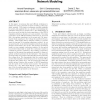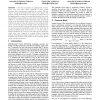139 search results - page 6 / 28 » Distributed sleep transistor network for power reduction |
DAC
2002
ACM
14 years 8 months ago
2002
ACM
Reducing power dissipation is one of the most principle subjects in VLSI design today. Scaling causes subthreshold leakage currents to become a large component of total power diss...
ASPLOS
2012
ACM
12 years 2 months ago
2012
ACM
Numerous data center services exhibit low average utilization leading to poor energy efficiency. Although CPU voltage and frequency scaling historically has been an effective mea...
ISPD
2007
ACM
13 years 8 months ago
2007
ACM
In this paper, we propose fast and efficient techniques to analyze the power grid with accurate modeling of the transistor network. The solution techniques currently available for...
ICDCSW
2003
IEEE
14 years 11 days ago
2003
IEEE
We present an integrated dual approach to reduce power consumption in infrastructure-mode 802.11 wireless LANs. A novel distributed power control algorithm adaptively adjusts the ...
DAC
2005
ACM
14 years 8 months ago
2005
ACM
- The large magnitude of supply/ground bounces, which arise from power mode transitions in power gating structures, may cause spurious transitions in a circuit. This can result in ...


